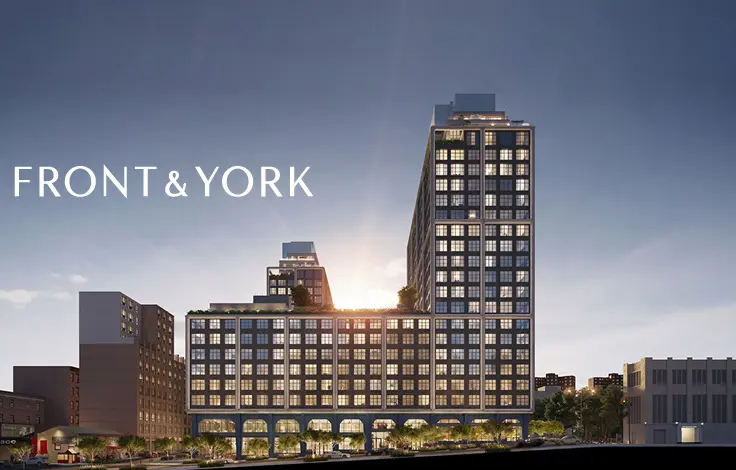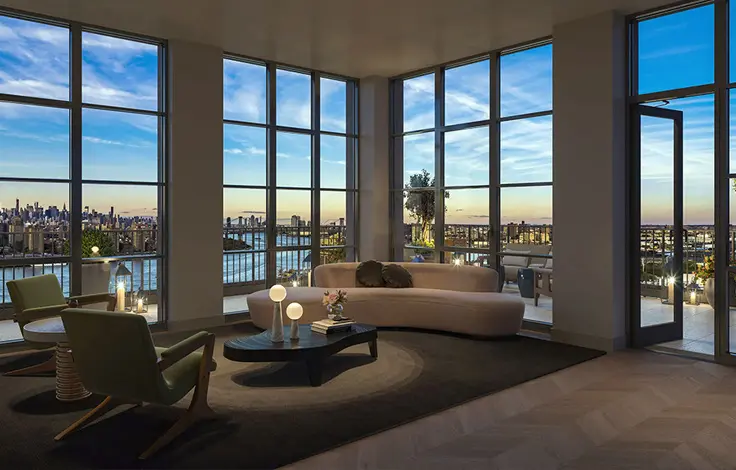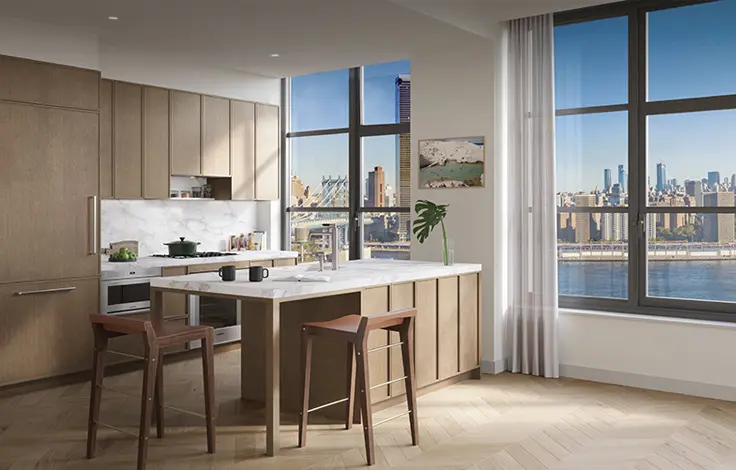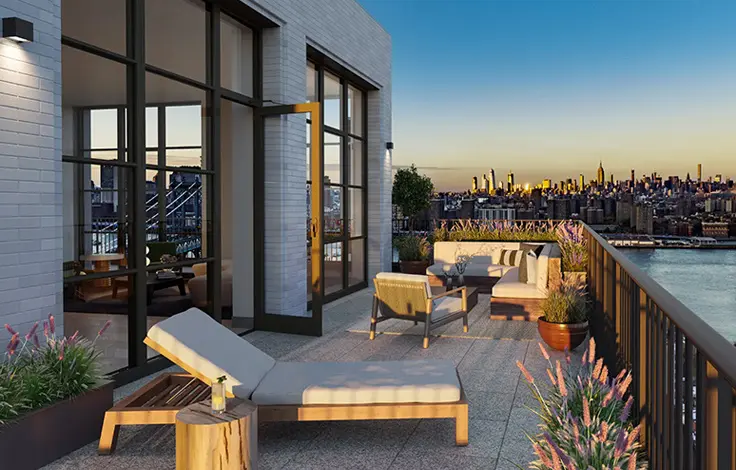 Carter Horsley
Carter HorsleyDec 23, 2011
Carter's Review
Bayard Street fronting on McCarren Park in the Greenpoint section of Brooklyn is one of the city's most remarkable real estate development stories in recent years.
Four different parcels have been built with four completely different architectural styles. Three of them were designed, Karl Fischer, who has become one of the most prolific architects active in Brooklyn.
This is the fourth building and probably the most interesting for its very bold but rather bizarre design.
It is known as the Lotus and its address is 2 Bayard Street and it is also known as 610 Union Avenue. It was developed by 2 Bayard Holdings LLC and designed by Abraham Hertzberg of Hertzberg & Sanchez, according to an article by Linda Collins in the Brooklyn Eagle November 5, 2005.
It has 19 one-bedroom apartments and is pet-friendly. Apartments on the top three floors have mezzanines.
It was erected starting in 2004 on a former junkyard.
The cityseen.wordpress.com website described the building in 2006 as a "gem of internationalist design (think Brasilia)...replete with 'Orientalist' detailed railings."
The website article had many interesting comments:
WFS said he/she was "not one to be scared of modernist architecture..., but there is something really visually unsettling about the design," adding that "sadly, it is the best-looking of all the buildings on that block."
"Loser" wrote that it "looks like a 1970s Dutch housing project."
Another article at brownstoner.com also elicited numerous comments. One person said it was "truly hideous" and another said it was "beyond ugly." Another person said he agreed that "the design is a bit dramatic and over the top but compared to what's out there it seems tolerable" and yet another person said "it looks like they put some thought into it; also, it doesn't dominate the block by being too large or too tall."
One commenter remarked that "it is an aggressive design..., but these apartments must have fantastic light - which is missing from a good number of new apartments, as well as many of the great old houses...."
Malymis wrote that "Actually is not bad, it has strong mid-century modern design language (kind of late modern actually) therefore very appropriate for aging hipsters. I bet they will love it. it is right on target. And I bet it was conscious design/marketing decision....It is not boring and very retro (in neo late modern sense) Way better than average new development."
Will also was rather impressed: "I like it, it has a 'groovy' feel....It's a good example of doing a lot with a little...The green is just paint (as far as I can tell) there are a few designs etched into concrete face, and the paint accents them. It gives the façade a nice 3-D efect, it 'pops' it's upbeat."
Naomi observed, however, that "Unfortunately, because of the façade material that was used (a spray-applied stucco finish that looks cheap and fuzzy up close) this building looks much better photographed than it does in person. And it looks better from across the park than it does from across the street. As my husband put it the other day, this is way too timid a material for such a bold geographic statement....er...I meant geometric statement...."
Dillo wrote "Architectural mediocrity at its finest!"
Gary W. in Long Beach wrote "Just paint over the diamond shapes with the oxidized copper green paint and it will look ok. Right now it looks like a chemical company headquarters from Tulsa or Phoenix in 1963."
In the marketing material for an apartment in the building, the 5-story building was described as "a fusion of metropolitan modern and parkside serenity." It said the building had a roof terrace and on-site parking. It said the apartment had 15-foot-high ceilings, wide-strip red oak hardwood floors, floor-to-ceiling windows leading out to a 16-foot-wide balcony overlooking the park, and central air-conditioning. The kitchen had solid maple cabinets, stainless steel gas stove, refrigerator, dishwasher and ventilation hood, black granite countertops and a custom mosaic glass tile backsplash. The bathroom was "dressed in important Noranda beige tile" and had a Kohler jet shower system. The closets had drawers, shelves and dividers.
McCarren Park is bordered by Bayard, North 12th and Lorimer Streets and Nassau Avenue. It was originally called Greenpoint Park but was renamed in 1909 McCarren
Park after Patrick Henry McCarren (1847-1909), a former New York State Senator.
McCarren Park is a 35-acre public park in New York City, USA. It is located in the Greenpoint neighborhood of Brooklyn, and is bordered by Nassau Avenue, Bayard Street, Lorimer Street and North 12th Street. It is operated by the New York City Department of Parks and Recreation.
The park is used for softball, volleyball, soccer, handball, and other games as well as running and sunbathing and dog-walking.
It has hosted craft fairs and rock concerts.
The McCarren Pool was the eighth of eleven giant pools built by the Works Progress Administration to open during the summer of 1936. With an original capacity for 6800 swimmers, the pool served as the summertime social hub for Greenpoint and Williamsburg. Wikipedia's entry for the park correctly observes that pool's "building's vast scale and dramatic arches, designed by Aymar Embury II, typify the generous and heroic spirit of New Deal architecture."
The pool, however, was closed in 1984. "The reuse and reconstruction of the pool remained a contentious community issue for many years, until the community came to a consensus plan in 2001. The community sought to reconstruct the facility to encompass a skate park, an indoor recreation/performance center, and a smaller pool that could be converted to a seasonal ice rink. The plan was estimated to cost $26 million and had a good chance of receiving public funding, but unfortunately, the budgetary constraints of the City post-9/11 shelved the plan and the pool remained abandoned for the next few years," according to the Wikipedia entry.
As part of the 2005 rezoning of Greenpoint and Williamsburg the City appropriated $1 million in capital budget funds for restoration of the pool as a performance space, and the next year the City Council allocated $300,000 to support the construction of a season rink.
In April, 2007, New York City Mayor Michael Bloomberg announced that a $50 million reconstruction of the pool was being funded as part of the City's PlaNYC long-term planning initiative. The New York City Landmarks Preservation Commission approved of the pool's renovation plan on September 9, 2008. Final design renderings were completed in February 2009, and renovation work began in December 2009.

- Condo built in 2006
- Located in Williamsburg
- 19 total apartments 19 total apartments
- 10 recent sales ($295K to $1.3M)
- Pets Allowed





 6sqft delivers the latest on real estate, architecture, and design, straight from New York City.
6sqft delivers the latest on real estate, architecture, and design, straight from New York City.
